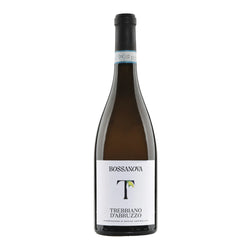Bossanova non è solo un famoso genere musicale brasiliano nato negli anni ’50, per opera di alcuni tra gli artisti sudamericani più ricchi di talento, come Antônio Carlos Jobim, Vinícius de Moraes e João Gilberto. È anche il nome di una cantina abruzzese, che si è messa in luce con vini molto interessanti. In realtà, tra la tradizione della musica brasiliana e il vino, un legame esiste. Così come l’incontro di tre straordinari artisti ha dato vita a un importante e innovativo movimento musicale, anche l’incontro tra Andrea Quaglia e Nat Colantonio, uno manager e l’altro musicista, è stato alla base del desiderio di creare un nuovo progetto nel settore della viticoltura, animato da una grande passione per la terra d’Abruzzo. La tenuta si trova nella zona collinare di Controguerra, in provincia di Teramo. Le vigne si estendono complessivamente su una superficie di circa nove ettari, in un’area da sempre molto vocata per la viticoltura, in virtù della sua particolare collocazione geografica. Situati a metà strada tra le alte vette dell’Appennino Abruzzese e il mar Adriatico, i vigneti di Controguerra beneficiano di un clima di carattere continentale piuttosto fresco, ma mitigato dalle brezze del mare, con notevoli escursioni termiche tra le temperature del giorno e della notte. Grazie a queste favorevoli condizioni, le uve arrivano a piena maturazione lentamente e accumulano profumi e aromi molto ricchi e intensi. La zona di Controguerra è particolarmente vocata per i vitigni autoctoni, in particolare per il Montepulciano d’Abruzzo e per il Trebbiano abruzzese. Proprio la presenza di due vitigni cosi importanti ha tenuto al riparo la regione dall’introduzione massiccia di vitigni internazionali. Le vigne sono condotte seguendo i principi della biodinamica e le antiche consuetudini, in armonia con la natura e nel rispetto di un ambiente incontaminato. Anche nelle pratiche di cantina si seguono processi poco invasivi, con fermentazioni spontanee catalizzate da lieviti indigeni, bassissima aggiunta di solforosa in fase di imbottigliamento e nessuna addizione di additivi enologici. Inoltre per le vinificazioni e gli affinamenti non si fa mai uso di botti di legno, ma soltanto vasche di cemento vetrificate o anfore (in particolare per il Trebbiano). Il risultato di questo approccio minimalista è un vino schietto e genuino, che esprime in modo diretto il vero carattere del terroir.
Bossanova non è solo un famoso genere musicale brasiliano nato negli anni ’50, per opera di alcuni tra gli artisti sudamericani più ricchi di talento, come Antônio Carlos Jobim, Vinícius de Moraes e João Gilberto. È anche il nome di una cantina abruzzese, che si è messa in luce con vini molto interessanti. In realtà, tra la tradizione della musica brasiliana e il vino, un legame esiste. Così come l’incontro di tre straordinari artisti ha dato vita a un importante e innovativo movimento musicale, anche l’incontro tra Andrea Quaglia e Nat Colantonio, uno manager e l’altro musicista, è stato alla base del desiderio di creare un nuovo progetto nel settore della viticoltura, animato da una grande passione per la terra d’Abruzzo. La tenuta si trova nella zona collinare di Controguerra, in provincia di Teramo. Le vigne si estendono complessivamente su una superficie di circa nove ettari, in un’area da sempre molto vocata per la viticoltura, in virtù della sua particolare collocazione geografica. Situati a metà strada tra le alte vette dell’Appennino Abruzzese e il mar Adriatico, i vigneti di Controguerra beneficiano di un clima di carattere continentale piuttosto fresco, ma mitigato dalle brezze del mare, con notevoli escursioni termiche tra le temperature del giorno e della notte. Grazie a queste favorevoli condizioni, le uve arrivano a piena maturazione lentamente e accumulano profumi e aromi molto ricchi e intensi. La zona di Controguerra è particolarmente vocata per i vitigni autoctoni, in particolare per il Montepulciano d’Abruzzo e per il Trebbiano abruzzese. Proprio la presenza di due vitigni cosi importanti ha tenuto al riparo la regione dall’introduzione massiccia di vitigni internazionali. Le vigne sono condotte seguendo i principi della biodinamica e le antiche consuetudini, in armonia con la natura e nel rispetto di un ambiente incontaminato. Anche nelle pratiche di cantina si seguono processi poco invasivi, con fermentazioni spontanee catalizzate da lieviti indigeni, bassissima aggiunta di solforosa in fase di imbottigliamento e nessuna addizione di additivi enologici. Inoltre per le vinificazioni e gli affinamenti non si fa mai uso di botti di legno, ma soltanto vasche di cemento vetrificate o anfore (in particolare per il Trebbiano). Il risultato di questo approccio minimalista è un vino schietto e genuino, che esprime in modo diretto il vero carattere del terroir.



